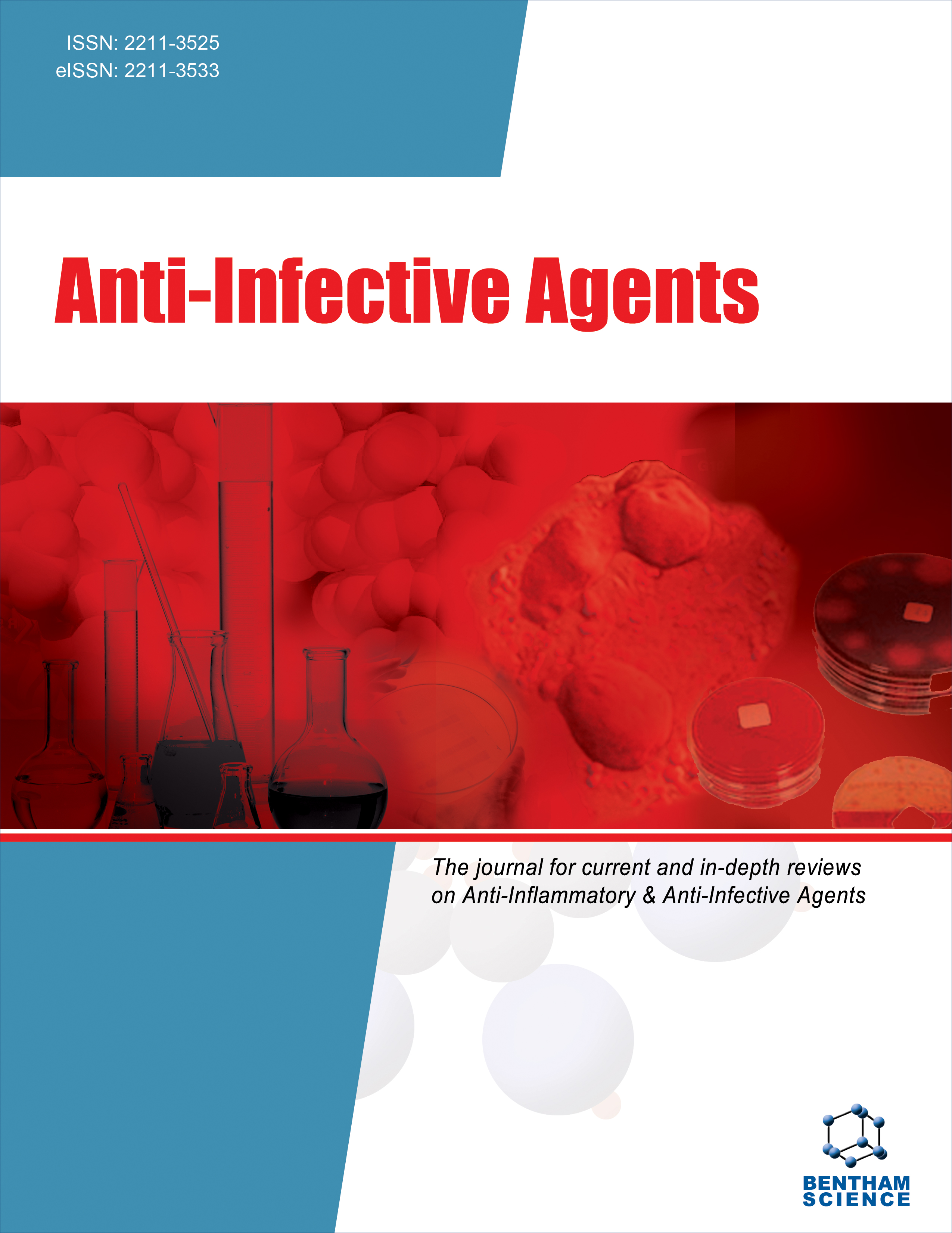- Home
- A-Z Publications
- Anti-Infective Agents
- Previous Issues
- Volume 13, Issue 2, 2015
Anti-Infective Agents - Volume 13, Issue 2, 2015
Volume 13, Issue 2, 2015
-
-
Helicobacter pylori Treatment: An Overview in 2015
More LessIntroduction: H. pylori is a flagellate Gram-negative bacterium living on the mucosal surface of the gastric epithelium. It is accepted that the antibiotic resistance is a major problem for treatment of diseases caused by infectious bacteria. Infection is generally acquired during childhood and persists life-long in the absence of antibiotic treatment. Because of development of quinolone-resistant pathogens, quinolone-based Read More
-
-
-
Synthesis and Biological Evaluation of 2-thiazolylimino-5-arylidene-4- thiazolidinone Derivatives as Potent Antimycobacterial Agents
More LessAuthors: Monika Jain, Rohani P. Burman, Villendra S. Negi, Sarbjit S. Jhamb, Alka Mital and Manjinder S. GillBackground: The recent emergence of multi-drug resistant (MDR) and extensively drugresistant (XDR) cases of tuberculosis has lead to the search for new structural classes of anti-TB drugs that can be effective against these strains of Mycobacterium tuberculosis. In the present study a series of 2-thiazolylimino-5-arylidene-4-thiazolidinone derivatives, unsubstituted and mono-substituted with hydroxy, methoxy, fluoro, chloro an Read More
-
-
-
Synthesis and Evaluation of New 5-methylisoxazole-3-carboxamide Derivatives as Antitubercular Agents
More LessAuthors: Neenu Ganesh, Gurubasavarj V. Pujar and Bharat K. InturiBackground: Tuberculosis is responsible for the world’s leading cause of death affecting one third of the world’s population by the latent or dormant form despite the current chemotherapy. For the effective management of MDR or XDR-TB, new lead compounds or novel therapeutic targets are urgently needed. The present investigation is aimed at creating a new and hitherto unreported molecular framework encompassing isox Read More
-
-
-
Preliminary Screening Indicates Promising Antimicrobial Properties of the Stem Bark Extracts of Macaranga rosea
More LessAuthors: Bolaji O. Akanbi, Prema Anene and Segun OlayanjuBackground/Purpose: Medicinal plant extracts with potent antimicrobial activity are potentially useful sources of new and novel antimicrobial agents. We investigated the extracts from the stem bark of Macaranga rosea antimicrobial activity. Methods: Cold extraction procedures were used to obtain extracts followed by standard qualitative assays for phytochemicals. Agar well diffusion and macrobroth dilution assays were u Read More
-
-
-
Synthesis of Nitrogen and Oxygen based Pyrazole Derivatives and Its Antitubercular and Antimicrobial Activity
More LessAuthors: Khushal M. Kapadiya, Kishor M. Kavadia, Parth A. Manvar and Ranjan C. KhuntBackground: Pyrazole, oxazole and pyrimidine are nitrogen containing heterocycles which possess very good binding efficiency with receptor or proteins. Due to this effect it can be work as antitubercular agents with active substituents. The objective of this paper is clubbed the heterocycles to enhance their antitubercular potency. Methods: The active substituted pyrazole aldehydes were synthesized by reaction of phenyl hyd Read More
-
-
-
Synthesis, Biological Evaluation, in Silico Docking and Virtual ADME Studies of Novel Isatin Analogs as Promising Antimicrobial Agents
More LessAuthors: Biplab Debnath and Swastika GangulyBackground: A series of sixteen novel isatin analogs (3a-3p) have been synthesized and evaluated for their antibacterial and antifungal activities against various pathogenic microorganisms. Gram-positive bacterial strains: Staphylococcus aureus, Bacillus subtilis; Gram-negative bacterial strains: Escherichia coli, Pseudomonas aeruginosa, Salmonella typhi, Klebsiella pneumonia, and fungal strains Candida albicans, Aspergil Read More
-
-
-
Synthesis and Antiviral Activity of Dihydropyrimidines - Ciprofloxacin Mannich bases Against Various Viral Strains
More LessBackground: Dihydropyrimidinone is considered as a pharmacophoric skeleton in many drug discovery programmes. To explore the activity of dihydropyrimidines, we regioselectively synthesized some of the substituted mannich bases of dihydropyrimidinone (DHPM) analogues regioselectively with fluoroquinolones (Ciprofloxacin). Methods: Regioselectivity in these structures is achieved by the influence of weak Read More
-
Most Read This Month
Article
content/journals/aia
Journal
10
5
false
en


